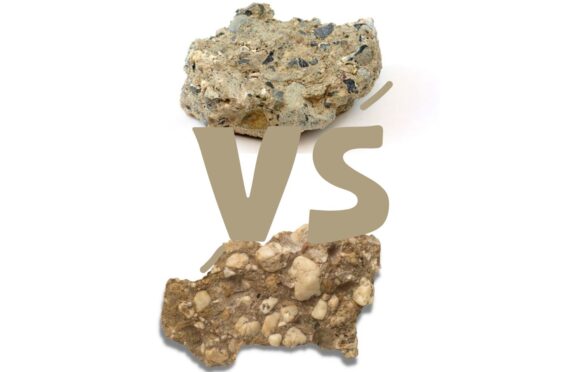
What is the Difference Between a Conglomerate and a Breccia?
Geology is a fascinating field that involves the study of rocks and the processes that formed them. Two types of sedimentary rocks that are often confused with each other are conglomerates and breccias. Although they share some similarities, there are also significant differences between them. This article will explore the key features that differentiate conglomerates from breccias.
What is a Conglomerate?
A conglomerate is a type of sedimentary rock that is composed of rounded to sub-rounded fragments of various sizes and types of rocks. These fragments, also known as clasts, are held together by a natural cementing material, such as silica, calcium carbonate, or iron oxide. Conglomerates are typically formed by the deposition of gravel in a high-energy environment, such as a river or a beach. The clasts in a conglomerate can range in size from a few millimeters to several meters, and they are usually well-rounded due to the erosive forces of the transporting medium.
Conglomerates are classified based on the size of their clasts. Pebble conglomerates contain clasts that are 2-64 mm in diameter, while cobble conglomerates have clasts that are 64-256 mm in diameter. Boulder conglomerates contain clasts that are larger than 256 mm in diameter.
What is a Breccia?
A breccia is a type of sedimentary rock that is composed of angular to sub-angular fragments of various sizes and types of rocks. Unlike conglomerates, breccias are not well-rounded, and their fragments have sharp edges and corners. Breccias are typically formed by the deposition of debris in a high-energy environment, such as a landslide or a volcanic eruption. The fragments in a breccia can range in size from a few millimeters to several meters, and they are usually held together by a natural cementing material, such as silica, calcium carbonate, or iron oxide.
Breccias are classified based on the size of their fragments. Matrix-supported breccias contain a fine-grained matrix that fills the spaces between the fragments, while clast-supported breccias have fragments that are packed together with little or no matrix.
Differences between Conglomerates and Breccias
The main difference between conglomerates and breccias is the shape of their clasts. Conglomerates contain well-rounded clasts, while breccias contain angular to sub-angular clasts. This difference is due to the different types of transport processes that form these rocks. Conglomerates are formed by the transport of gravel in a high-energy environment, which rounds the clasts through erosion. Breccias, on the other hand, are formed by the deposition of debris in a high-energy environment, which results in angular fragments with sharp edges and corners.
Another difference between these rocks is their texture. Conglomerates have a coarse-grained texture, while breccias have a coarse to fine-grained texture. This is because the cementing material in conglomerates is usually coarser than the cementing material in breccias, which results in a coarser texture.
Conclusion
In summary, conglomerates and breccias are two types of sedimentary rocks that are often confused with each other. Conglomerates are composed of well-rounded clasts that are held together by a natural cementing material, while breccias are composed of angular to sub-angular fragments that are held together by a natural cementing material. The main difference between these rocks is the shape of their clasts, which is due to the different types of transport processes that form them. Understanding these differences is important for geologists who study sedimentary rocks, as they can provide important information about the geological processes that occurred in a particular area. By examining the characteristics of conglomerates and breccias, geologists can gain insights into the history of the environment in which these rocks were formed.
Conglomerates and breccias are both economically important rocks that are used in construction and as decorative stones. Pebble and cobble conglomerates are often used as decorative stones in gardens and landscaping, while boulder conglomerates are used as building materials in road construction and other civil engineering projects. Breccias are also used in construction as building stones and as decorative stones.
In conclusion, the difference between conglomerates and breccias lies in the shape of their clasts and the texture of the rock. Conglomerates are composed of well-rounded clasts and have a coarse-grained texture, while breccias are composed of angular to sub-angular fragments and have a coarse to fine-grained texture. These differences are due to the different types of transport processes that form these rocks. Understanding these differences is essential for geologists and anyone working in the construction industry, as it can provide valuable insights into the history of the environment in which these rocks were formed and their potential uses in construction projects.
